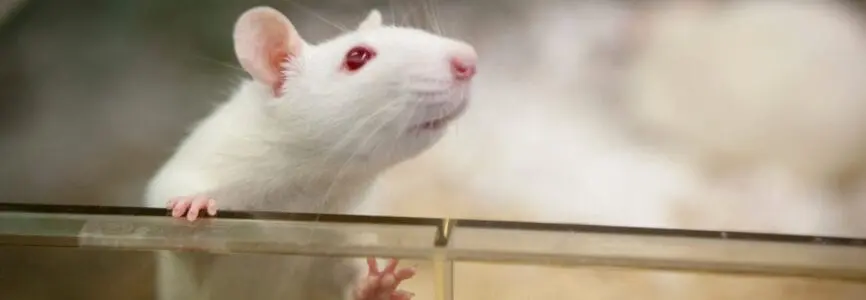Bioethics Forum Essay
Rats Have Empathy, But What About the Scientists Who Experiment on Them?
Decades of experiments have shown that rats are smart individuals that feel pain and pleasure, care about one another, can read others’ emotions, and will help unfamiliar rats even at a cost to themselves. It’s time to apply what we’ve learned from these animals and stop conducting experiments on them in laboratories.
Recently, there was substantial media coverage of experiments at Japan’s Kwansei Gakuin University demonstrating that rats will help other rats in need and even prioritize helping others over receiving a tasty reward.
The experimenters placed one rat in a water-filled tank, a situation that terrifies rats and from which they try desperately to escape to avoid drowning. A second rat on a platform had to figure out how to push open a door to help the drowning rat reach a dry area. The experimenters observed that rats quickly learned to open the door to rescue their cagemates. When given the choice between opening one door to save a drowning rat and opening another door to secure a chocolate treat, the platform rats helped the distressed rat first – and then shared the treat with the rescued rat. Rats who had themselves previously been thrown into the water tank were faster at opening the door to help their panicked cohorts.
This study is only the latest in a string of experiments spanning nearly 60 years demonstrating that rats show sympathy for pain and distress experienced by other rats and take action to help them.
In experiments conducted at Brown University in the 1950s, rats who had been trained to press a lever for food stopped pressing the lever when they realized that with each press, a rat in an adjoining cage would cry out in pain (after experiencing an electric shock).
In the 1960s, experimenters used electric shocks to train rats to press a lever to lower a block that was suspended from a hoist. The experimenters then used the hoist to suspend a rat in a harness, and their notes stated, “This animal typically squealed and wriggled satisfactorily while suspended, and if it did not, it was prodded with a sharp pencil until it exhibited signs of discomfort.” A rat observing the situation from the floor would press a lever to lower the beleaguered rat to safety, even if the rat wasn’t at risk of a shock.
As we know from the most recent example in Japan, such morbid curiosity about the well-documented physical and emotional pain and distress of rodents has unfortunately persisted. In 2011, experimenters at the University of Chicago conducted experiments testing for “empathically motivated pro-social behavior” in rats. A “free” rat was placed in a space with a cagemate who was trapped in a restraining tube that neither had seen before. The trapped rats communicated their distress with ultrasonic alarm calls, and the experimenters observed that the free rats “circled the restrainer, digging at it and biting it, and contacted the trapped rat through holes in the restrainer . . . .” Eventually, the free rats learned to liberate their trapped cagemates, the experimenters wrote, “by applying enough force to tip open the restrainer door . . . . They freed cagemates even when social contact was prevented. When liberating a cagemate was pitted against chocolate contained within a second restrainer, rats opened both restrainers and typically shared the chocolate.”
Rats consistently exhibit empathy, altruism, and fairness.
But what can be said about the emotional intelligence of the experimenters who intentionally inflict stress and terror on rats while knowing full well how the animals suffer and worry about the suffering of others?
Unfortunately, many experimenters miss the forest for the trees. Instead of following this evidence to its logical conclusion that millions of rats shouldn’t be confined, burned, shocked, infected, and crippled in laboratories – or should at least receive some basic protections under the law – many use it as the basis for even more experiments. At least one such experimenter recently acknowledged the inherent conflict: “The more we do experiments like this, the more we wonder if we should do experiments like this.”
Alka Chandna, PhD, is a senior laboratory oversight specialist for People for the Ethical Treatment of Animals (PETA).
Posted by Susan Gilbert at 06/24/2015 01:14:59 PM |













